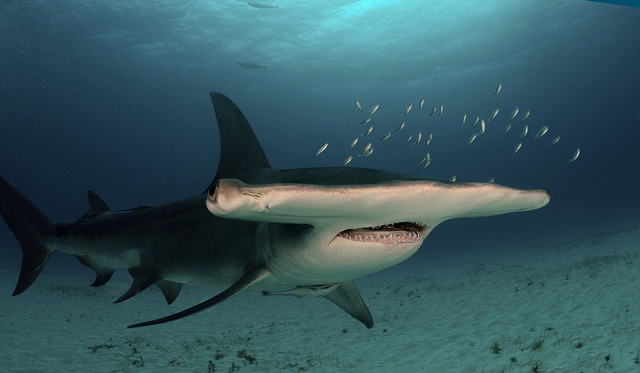Hello ladies and gents this is the viking telling you that today we are talking about
GREAT HAMMERHEAD
The great hammerhead (Sphyrna mokarran) is the largest species of hammerhead shark, belonging to the family Sphyrnidae, attaining a maximum length of 6.1 m (20 ft). It is found in tropical and warm temperate waters worldwide, inhabiting coastal areas and the continental shelf. The great hammerhead can be distinguished from other hammerheads by the shape of its "hammer" (called the "cephalofoil"), which is wide with an almost straight front margin, and by its tall, sickle-shaped first dorsal fin.
A solitary, strong-swimming apex predator, the great hammerhead feeds on a wide variety of prey ranging from crustaceans and cephalopods, to bony fish, to smaller sharks. Observations of this species in the wild suggest that the cephalofoil functions to immobilize stingrays, a favored prey. This species has a viviparous mode of reproduction, bearing litters of up to 55 pups every two years.
Although potentially dangerous, the great hammerhead rarely attacks humans. It sometimes behaves inquisitively toward divers and should be treated with respect. This shark is heavily fished for its large fins, which are extremely valuable on the Asian market as the main ingredient of shark fin soup. As a result, great hammerhead populations are declining substantially worldwide, and it has been assessed as Endangered and change to Critically Endangered by the International Union for Conservation of Nature (IUCN).
The streamlined body of the great hammerhead with the expanded cephalofoil is typical of the hammerhead sharks. Adult great hammerheads can be distinguished from the scalloped hammerhead and the smooth hammerhead by the shape of the cephalofoil, which has a nearly straight front margin (as opposed to arched), with prominent medial and lateral indentations. The width of the cephalofoil is 23–27% of the body length. The teeth are triangular and strongly serrated, becoming more oblique towards the corners of the mouth. There are 17 tooth rows on either side of the upper jaw with 2–3 teeth at the symphysis (the midline of the jaw), and 16–17 teeth on either side of the lower jaw and 1–3 at the symphysis.
The first dorsal fin is distinctive, being very tall and strongly falcate (sickle-shaped), and originates over the insertions of the pectoral fins. The second dorsal fin and anal fin are both relatively large, with deep notches in the rear margins. The pelvic fins are falcate with concave rear margins, in contrast to the straight-margined pelvic fins of the scalloped hammerhead.
The skin is covered with closely placed dermal denticles. Each denticle is diamond-shaped, with 3–5 horizontal ridges leading to marginal teeth in smaller individuals, and 5–6 in larger ones. The great hammerhead is dark brown to light gray to olive above, fading to white on the underside. The fins are unmarked in adults, while the tip of the second dorsal fin may be dark in juveniles.
The average great hammerhead measures up to 3.5 m (11 ft) long and weighs over 230 kg (510 lb). A small percentage of the population, mostly or all females, are much larger. The longest great hammerhead on record was 6.1 m (20 ft). The heaviest known great hammerhead is a 4.4 m (14 ft) long, 580 kg (1,280 lb) female caught off Boca Grande, Florida in 2006. The weight of the female was due to her being pregnant with 55 near-natal pups
And as always have a chilled day from the Viking.

Comments
Post a Comment